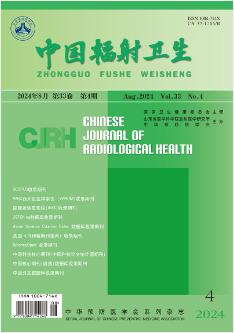透镜剂量计和环形剂量计部分剂量学性能的实验研究
引用次数: 0
摘要
Objective To compare the test results of domestic and imported eye lenses and ring dosimeters, and master some dosimeter performance indexes of eye lenses and ring dosimeters Methods Recording to IEC 62387-2012 and GBZ 128-2019, the performance of the eye lens dosemeters and ring dosemeters with the domestic thermoluminescence detectors were compared with the imported thermoluminescence detectors in photo response The dose response deviation of the imported eye lens dosimeter and imported ring dosimeter was studied under the same iration condition The difference of linear response between imported ring dosimeter and domestic ring dosimeter was studied under the same radiation condition The results of the same dose were IRADIATED to domestic and imported thermoluminescences detectors in the imported eye lens and imported ring dosimeters, and the linear correlation coefficient all met R 2>0.999 The maximum response deviation of the imported eye lens dosimeter and ring dosimeter was less than 10.0% for the same dose Two types of imported ring dosimeters and one type of domestic ring dosimeter were iratiated with the same dose, and the linear correlation coefficient all met R 2>0.99 Conclusion Both domestic detectors and imported detectors can meet the needs of monitoring requirements There was no objective difference in linear response between imported ring dosimeter and domestic ring dosimeter The repeatability of imported eye lens dosimeter and imported ring dosimeter met the performance requirements of the dosimeter Abstract: Objective: To compare the partial performance test results of domestic and imported ophthalmic lenses and ring dosimeters, and to grasp some dosimetric performance indicators of ophthalmic lenses and ring dosimeters. According to the neutral energy requirements of IEC 62387-2012 and GBZ 128-2019, comparative experiments were conducted on the performance of eye crystal dosimeters and ring dosimeters under photon response using domestic and imported thermoluminescent detectors, respectively; Test the dose response deviation of imported ophthalmic lenses and finger ring dosimeters under the same irradiation conditions twice; Test the difference in linear response between imported and domestic ring dosimeters under the same irradiation conditions. The results showed that domestic and imported thermoluminescent detectors were used to irradiate the same dose in the eye lens and ring dosimeters, respectively, with linear correlation coefficients of R>0.999; The maximum response deviation of imported eye lens dosimeters and finger ring dosimeters for the same dose after two exposures is less than 10.0%. Two imported ring dosimeters and one domestic ring dosimeter meet the linear correlation coefficient of R>0.99 for the same dose exposure. Conclusion: Both domestic and imported detectors can meet the monitoring needs; The difference in linear response between imported and domestic ring dosimeters is not significant; The repeatability of imported eye lens dosimeters and imported ring dosimeters meets the performance requirements of dosimeters.本文章由计算机程序翻译,如有差异,请以英文原文为准。
Experimental research on partial dosimetric performance for eye lens dosimeter and ring dosimeter
Objective To compare the test results of domestic and imported eye lens and ring dosimeters,
and master some dosimetric performance indexes of eye lens and ring dosimeters.
Methods According to IEC 62387—2012 and GBZ 128—2019, the performance of the eye lens dosimeters
and ring dosimeters with the domestic thermoluminescence detectors were compared with
the imported thermoluminescence detectors in photon response. The dose response deviation
of the imported eye lens dosimeter and imported ring dosimeter was studied under the
same irradiation condition. The difference of linear response between imported ring
dosimeter and domestic ring dosimeter was studied under the same irradiation condition.
Results The same dose was irradiated to domestic and imported thermoluminescence detectors
in the imported eye lens and imported ring dosimeters, and the linear correlation
coefficient all met R
2 > 0.999. The maximum response deviation of the imported eye lens dosimeter and ring
dosimeter was less than 10.0% for the same dose. Two kinds of imported ring dosimeters
and one kind of domestic ring dosimeter were irradiated with the same dose, and the
linear correlation coefficient all met R
2 > 0.99.
Conclusion Both domestic detectors and imported detectors can meet the needs of monitoring requirements.
There was no obvious difference in linear response between imported ring dosimeter
and domestic ring dosimeter. The repeatability of imported eye lens dosimeter and
imported ring dosimeter met the performance requirements of the dosimeter.
摘要: 目的 比较国产与进口眼晶体、指环剂量计的部分性能测试结果, 掌握眼晶体、指环剂量计的部分剂量学性能 指标。
方法 依据IEC 62387—2012和GBZ 128—2019中性能要求, 分别使用国产和进口热释光探测器开展了眼晶 体剂量计和指环剂量计在光子响应下的性能对比实验;测试进口眼晶体和指环剂量计在相同照射条件下照射2次的
剂量响应偏差;测试进口指环剂量计和国产指环剂量计在相同照射条件下的线性响应区别。
结果 在眼晶体和指环剂 量计中分别使用国产热释光探测器和进口热释光探测器照射相同剂量, 线性相关系数均满足
R > 0.999;进口眼晶体 剂量计和指环剂量计2次照射相同剂量的响应偏差最大值均小于10.0%。两种进口指环剂量计和一种国产指环剂量 计照射相同剂量线性相关系数均满足
R > 0.99。
结论 国产探测器和进口探测器均能满足监测需要;进口指环剂量 计和国产指环剂量计线性响应区别不明显;进口眼晶体剂量计和进口指环剂量计重复性满足剂量计的性能要求。
求助全文
通过发布文献求助,成功后即可免费获取论文全文。
去求助
来源期刊
CiteScore
0.80
自引率
0.00%
发文量
7142
期刊介绍:
Chinese Journal of Radiological Health is one of the Source Journals for Chinese Scientific and Technical Papers and Citations and belongs to the series published by Chinese Preventive Medicine Association (CPMA). It is a national academic journal supervised by National Health Commission of the People’s Republic of China and co-sponsored by Institute of Radiation Medicine, Shandong Academy of Medical Sciences and CPMA, and is a professional academic journal publishing research findings and management experience in the field of radiological health, issued to the public in China and abroad. Under the guidance of the Communist Party of China and the national press and publication policies, the Journal actively publicizes the guidelines and policies of the Party and the state on health work, promotes the implementation of relevant laws, regulations and standards, and timely reports new achievements, new information, new methods and new products in the specialty, with the aim of organizing and promoting the academic communication of radiological health in China and improving the academic level of the specialty, and for the purpose of protecting the health of radiation workers and the public while promoting the extensive use of radioisotopes and radiation devices in the national economy. The main columns include Original Articles, Expert Comments, Experience Exchange, Standards and Guidelines, and Review Articles.

 求助内容:
求助内容: 应助结果提醒方式:
应助结果提醒方式:


